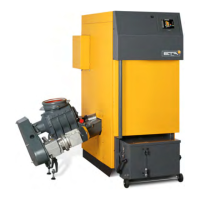6.6.3.1 Adjusting the heating curve
Adjusting the heating curve
The heating curve is adjusted through the settings of
the heating circuit ( button) in the heating curve
menu ( button). How the heating curve is altered
depends on whether the rooms are always too warm or
too cold at outdoor temperatures above freezing or
below freezing.
Make adjustments to the heating curve in small
increments only. For underfloor heating, never
change more than 2 °C at once, and for radiators never
more than 4 °C. You may need to adapt the heating
curve again after a couple of days, but if you, do it in
small increments, it is more precise and energy
efficient.
At outdoor temperatures above freezing, the
rooms are always too hot or too cold:
1. Only parameter [Flow at +10 °C] is adjusted.
2. Change the selector switch to the heating mode
position ( ). Use the arrow keys to
reduce parameter [Flow at +10 °C] if it is too warm,
or increase if it is too cold.
Fig. 6-51: Adjust heating curve (at outdoor temperatures
above freezing)
At outdoor temperatures below freezing, the
rooms are always too hot or too cold:
1. Only parameter [Flow at -10 °C] is adjusted.
2. Change the selector switch to the heating mode
position ( ). Use the arrow keys to
reduce parameter [Flow at -10 °C] if it is too warm,
or increase if it is too cold.
Fig. 6-52: Adjust heating curve (at outdoor temperatures
below freezing)
Outside the heating times, the rooms are always
too hot or too cold:
1. Then only the reduction is adjusted with parameter
[Set-back difference].
2. Change the selector switch to the reduced
operation mode position ( ). Use the
arrow keys to reduce parameter [Set-back
difference] if it is too cold, or increase if it is too
warm.
Fig. 6-53: Adjust reduced operation mode
With underfloor heating, reduced operation mode is
only partially noticeable because this heating system
reacts very slowly due to the high thermal mass of the
screed. Changes in parameters [Set-back difference]
are therefore often not noticeable.

